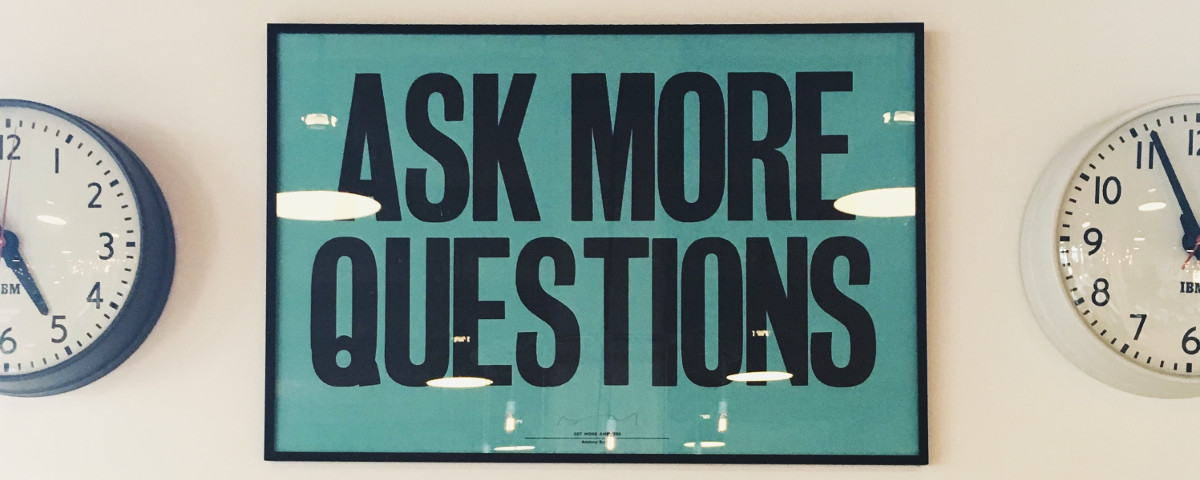- Blog
- Why we need more critical thinking and how to develop the necessary skills in your organization
Contents
- One size does not fit all - critical thinking, communication and collaboration are key.
- How can organizations, teams and individuals become more critical?
- Tackle complex issues with a structured problem-solving approach.
- Conduct challenging session that encourages your employees to critically discuss concepts, proposals, products etc. from different points of view.
- Ask for feedback and provide feedback on a regular basis.
- Don’t micromanage but empower your employees to come up their own solutions.
- There is no right or wrong in most cases.
- Do your own research: “Go to Gemba”.
- Conclusion
- References and further reading
The way leadership, its foundation and implementation was conveyed to us followed a very simplistic and “one fits all” understanding of leadership. This is in stark contrast to the vast amount of empirical findings, theoretical leadership models and evidence based knowledge that has been created during many years of research in social science. In addition, recent approaches such as authentic leadership and the general trend to “leadership as practice” weren’t addressed at all.
One size does not fit all - critical thinking, communication and collaboration are key.
Most of the discussions that took place during the training evolved around the tasks prepared by the trainers and followed the general line of argumentation of the training. There were only a few if at all discussions about different perspectives, approaches and ways to implement leadership. This lack of critical thinking that took place during the training is just one example of how most of us tend to accept simple, easy to understand and at first glance appealing solutions, concepts and decisions. This example is just one case of an alarming trend to “copy and paste” (Dunn et al., 2008) whatever we are exposed to without critically reflecting on potential consequences for us, our organization and the wider society.
This is especially relevant since critical thinking is a key skill that has to potential to increase individual and organizational performance. For instance, critical thinking empowers people to scrutinize things and thus draw on the basic psychological need of autonomy and competence which has a positive impact on motivation (Deci and Ryan, 2000). On an organizational level, research supports the claim that High Reliability Organizations (HRO) tend to not easily accept simple solutions to solve problems (LaPorte and Consolini, 1991). Instead, they dig deeper in order to get to the root cause of the problem and find a sustainable solution. Applied to leadership, critical thinking is the very basis to understand, analyse and at least mitigate wicked problems that represent some of the most challenging issues an organization and society as a whole facees (Grint, 2016). Finally, critical thinking is the very basis that drives an individual and an organization to leave its comfort zone and learn, develop and grow.
How can organizations, teams and individuals become more critical?
However, there is no easy to implement recipe on how to improve your, your employees and your organizations critical thinking skills. Following our evidence-based learning approach, we collected a set of principles that draw on research findings and provide guidance on how to improve critical thinking skills. We will start on an organizational level, followed by a focus on teams and finally will address the individual level.
Embed critical thinking in your organization’s strategy.
One of the most powerful tools to establish critical thinking in your organization is to simply put it your organization’s strategy. This sounds straightforward, but it isn't since many organizations still prefer to focus on “hard facts” in their strategy. However, having it document won’t be sufficient. The organization is only going to change when the strategy is communicated on a regular basis. There is strong evidence that language is a powerful enabler of sustainable change (Butcher and Atkinson, 2001). You just have to use it, repeat it, refer to it and reframe it on a regular basis.
Be aware of group and individual dynamics that undermine critical thinking.
Working in teams can significantly boost organizational performance (West et al., 2006). However, be aware that team work always involves group dynamics that can hamper critical thinking and the quality of decision making. For instance, research indicates that group discussions tend to reinforce an initially dominant position taken by a majority of the group. This effect is called group polarization (Myers and Lamm, 1976) and can lead to group think in cases where teams act to preserve a positive group identity, act under pressure and follow a poor decision making procedure (Esser, 1998) . Groupthink is characterized by a total absence of critical thinking but a strong and unanimous support of the prevailing opinion. Being aware of such group dynamics is the very basis to avoid any pitfall due to a lack of critical thinking.
Management skills newsletter
Join our monthly newsletter to receive management tips, tricks and insights directly into your inbox!
Tackle complex issues with a structured problem-solving approach.
Even though it might make us feel uncomfortable, we must accept that the world around us is not as simple as we might sometimes wish or think. Thus, problem solving processes that lead to simple right or wrong, department A or B, supplier Y or Z solutions usually address the tip of the iceberg only. Research tells us that organizations such as fire-fighting crews, aircraft carriers and nuclear power plants that operate in high risk environments share the common characteristic to avoid oversimplification (LaPorte and Consolini, 1991). Instead, they take the time, energy and resources to get to the bottom of the problem and address its root cause. Thus, don’t accepts the first and most compelling solution to an issue, but follow a structured problem-solving approach.
Conduct challenging session that encourages your employees to critically discuss concepts, proposals, products etc. from different points of view.
Critical thinking starts with respecting and appreciating different points of view, opinions and approaches to tackle issues. While this might sound obvious, it is not. In order to guide an organization into the right direction, it requires rituals and repetition. So called “Challenging Sessions” are such a ritual that can be easily integrated into daily business. Whenever a new product, service, document, presentation or any other important deliverable is going to be launched, distributed or published, key people with expertise and exposure meet for a meeting or a workshop. Following predefined key-questions such as “What key message does the presentation deliver?”, “Do we address our target audience?” the team critically discusses the deliverable from different points of view. A team moderator makes sure that the discussion stays constructive and fair.
 Ask for feedback and provide feedback on a regular basis.
Ask for feedback and provide feedback on a regular basis.
It sounds easy but it isn’t. Giving and receiving feedback requires a safe and trust-based environment as well as social skills and sensitivity both by the feedback giver and receiver. However, when these prerequisites are in place, the organization as a whole is continuously developing and learning. The key driver behind this upward spiral is again critical thinking. Learning and development does only take place when people recognize issues, address them in a constructive way and learn how to improve for the better.
Don’t micromanage but empower your employees to come up their own solutions.
Critical thinking is closely connected to empowerment, competency and autonomy. As a leader your task is to encourage and empower your employees and co-workers to come up with their own ideas, solutions and questions. However, this does not mean that your work is done when you refrain from micromanagement. Instead it is all about building and maintaining the right environment for your people, team and colleagues to strive. This involves creating a trust-based and safe environment generally referred to as speak-up culture and the right leadership approach.
There is no right or wrong in most cases.
Did you ever ask a lawyer about whether a certain decision is right or wrong? You most properly got the answer: “It depends on the context.” While lawyers and some consultant have applied the “principle of relativity” for many years now, it has started to get traction in management only recently. The key message behind this principle is that especially in the social world we live, right or wrong usually depends on the point of view. This “relativity of truth” is strongly driven by experience, personality and organizational culture as well as the context or situation which influences how we see certain things. Just to be aware of the principle of relativity is another step towards creating and maintaining a culture of critical thinking in your organization which is in line with a postmodern approach of learning and development (Kilgore, 2004).
Do your own research: “Go to Gemba”.
Last but not least critical thinking starts with the way we think, act and behave. Thus, when we accepts every statement as “truth”, just rely on high-level Key Performance Indicators (KPI) and don’t dig deeper when it comes to problems but just address the symptoms all efforts to establish a culture of critical thinking won’t bear any fruits. One particular powerful strategy that can be easily applied comes from the Lean Management practice. “Go to Gemba” emphasis to need to visit the shopfloor and see things with your own eyes rather than talking about abstract KPI or problems which are not defined very well and thus hard to grasp. Transferred to the general business domain, one could say that it simply translates to “do your own research and don’t forget to think critically”.
Conclusion
Learning and development always has been connected to leaving one’s comfort zone, abandoning what has been taking for granted and not believing everything without a healthy level of scepticism. This is especially relevant in the 21st century knowledge economy where experts, consultants, politicians, companies etc. try to make a point with simple and easy to sell messages. In addition, the ability to create high quality knowledge is a competitive advantage for any organization. Thus, critical thinking which strongly contributed to the development of mankind, will even get more important in the future.
References and further reading
Butcher, D. and Atkinson, S. (2001) ‘Stealth, secrecy and subversion: The language of change’, Journal of Organizational Change Management, vol. 14, no. 6, pp. 554–569.
Deci, E. L. and Ryan, R. M. (2000) ‘The "What" and "Why" of Goal Pursuits: Human Needs and the Self-Determination of Behavior’, Psychological Inquiry, vol. 11, no. 4, pp. 227–268.
Dunn, D., Halonen, J. S. and Smith, R. A. (2008) Teaching critical thinking in psychology: A handbook of best practices, Chichester West Sussex, Malden MA, Wiley-Blackwell.
Esser, J. K. (1998) ‘Alive and Well after 25 Years: A Review of Groupthink Research’, Organizational Behavior and Human Decision Processes, vol. 73, 2-3, pp. 116–141.
Grint, K. (2016) ‘Problems, problems, problems: The social construction of ‘leadership’’, Human Relations, vol. 58, no. 11, pp. 1467–1494.
Kilgore, D. (2004) ‘Toward a postmodern pedagogy’, New Directions for Adult and Continuing Education, vol. 2004, no. 102, pp. 45–53.
LaPorte, T. and Consolini, P. (1991) ‘Working in Practice But Not in Theory: Theoretical Challenges of “High-Reliability Organizations”’, Journal of Public Administration Research and Theory.
Myers, D. G. and Lamm, H. (1976) ‘The group polarization phenomenon’, Psychological Bulletin, vol. 83, no. 4, pp. 602–627.
West, M. A., Guthrie, J. P., Dawson, J. F., Borrill, C. S. and Carter, M. (2006) ‘Reducing patient mortality in hospitals: The role of human resource management’, Journal of Organizational Behavior, vol. 27, no. 7, pp. 983–1002.
Top Rated
About the Author

Comments
Most Read Articles
Blog Categories
RELATED SERVICES








Add comment